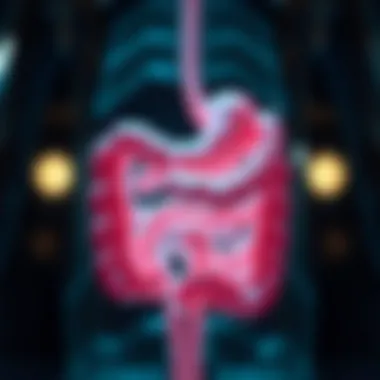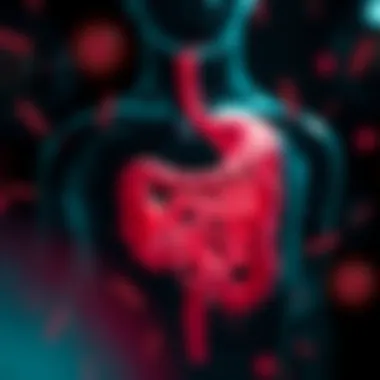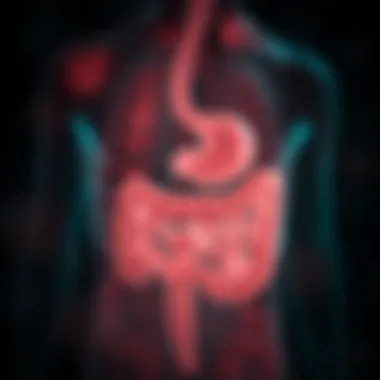The Effects of Xifaxan on Gut Microbiota Explained


Intro
The gut microbiota is a complex and dynamic ecosystem, hosting trillions of microorganisms that play essential roles in digestion, immunity, and overall health. As modern medicine evolves, antibiotics like Xifaxan have become mainstays in treating various gastrointestinal disorders. Yet, concerns loom about their impact on the delicate balance of gut bacteria.
Xifaxan, known generically as rifaximin, is commonly prescribed for conditions such as irritable bowel syndrome with diarrhea and certain types of bacterial infections. Its fame lies not only in its effectiveness but in its purported ability to target harmful bacteria while sparing beneficial species. But just how well does it achieve that?
In this exploration, we will delve into the nuances of Xifaxan's action, assess the latest findings from research, and scrutinize the implications for gut health. Grasping the effects of antibiotics on microbiota is not merely an academic exercise; it bears significant consequences for how we approach treatments in the context of overprescribing and the rising threat of antibiotic resistance. The dialogue surrounding antibiotic use, particularly in the realm of gut health, is more pertinent than ever.
Let's embark on this in-depth discussion by first unraveling some key concepts.
Preface
In the ever-evolving landscape of healthcare, the significance of gut health has garnered considerable attention. With the gut microbiota playing a pivotal role in various physiological processes, understanding the implications of antibiotic treatment on this delicate ecosystem becomes essential. This is particularly true for Xifaxan, which has been widely prescribed for certain gastrointestinal disorders. In this article, we aim to dissect the nuances of Xifaxan’s interaction with the gut microbiota, diving deep into its targeted action against harmful bacteria while assessing its potential effect on beneficial species.
The importance of this discussion cannot be understated. As we navigate through the complexities of antibiotic use, it’s vital to strike a balance between eradicating harmful pathogens and preserving the diversity of beneficial microbes within our digestive system. Increased awareness about the consequences of antibiotic overuse has raised concerns among healthcare professionals and patients alike. In light of this, our exploration into Xifaxan’s effects seeks to offer clarity on these pressing issues, focusing on both benefits and considerations that arise from its use in clinical settings.
Understanding Xifaxan
Xifaxan, known generically as rifaximin, is a broad-spectrum antibiotic that has made its mark particularly in treating travelers' diarrhea and irritable bowel syndrome with diarrhea. Its mechanism primarily involves inhibiting bacterial RNA synthesis, allowing it to target gram-positive and gram-negative bacteria effectively. However, what sets Xifaxan apart from conventional antibiotics is its limited absorption into the bloodstream, which means it predominantly works in the gut.
This characteristic is extremely relevant when contemplating the gut microbiome. The exactness of its action minimizes systemic side effects, thus offering a promising solution in situations where traditional antibiotics may wreak havoc on the microbiota. Not all antibiotics are created equal; the gentler nature of Xifaxan opens new possibilities for managing bowel disorders without disturbing the microbial balance excessively.
The Gut Microbiome
The gut microbiome—a complex community of trillions of microorganisms—plays an integral role in our health, influencing digestion, immune function, and even mental well-being. It comprises bacteria, viruses, fungi, and other microbes that coexist harmoniously, adapting to our dietary habits and overall lifestyle. This ecosystem can be fragile and easily disrupted by various factors, most notably antibiotics.
Antibiotic-induced dysbiosis, where beneficial bacterial populations decline, can lead to a range of health issues, from gastrointestinal disturbances to metabolic disorders. It is here that the relevance of Xifaxan grows even clearer. By potentially preserving beneficial gut flora while targeting specifically harmful strains, Xifaxan serves as a focal point in the dialogue about responsible antibiotic use. The implications of its usage extend beyond merely treating disease; they encompass the broader narrative of fostering a healthier gut through selective bacterial targeting.
In summary, as our understanding of the interplay between antibiotics and gut microbiota deepens, Xifaxan stands out as a significant case study. Its selective action opens avenues for more nuanced approaches to treatment that prioritize gut health while combating infections. Through this article, we seek to shed light on the multifaceted impacts of Xifaxan on gut microbiota, providing insights that can guide both clinical practices and patient choices.
Mechanism of Action
Understanding the mechanism of action is crucial when exploring how Xifaxan fits into the broader picture of gut health, especially given its role as an antibiotic. This section lays the groundwork for recognizing how this medication interacts with the gut microbiota. The significance of grasping these concepts extends beyond mere mechanistic insights; it has real-world implications for treatment strategies and the preservation of health.
Often, the effectiveness of an antibiotic hinges on its precision in targeting infections without wreaking havoc on beneficial bacteria. Xifaxan stands out for its targeted approach, aiming to minimize collateral damage to the gut flora during therapy. This balance may contribute to improved patient outcomes and tackling antibiotic resistance, a pressing issue in medicine today.
How Xifaxan Works
Xifaxan, or rifaximin, operates by inhibiting bacterial RNA synthesis through binding to the beta-subunit of bacterial RNA polymerase. This action curtails protein production in bacteria, ultimately inhibiting their growth and propagation. Unlike many systemic antibiotics that can disrupt flora extensively, Xifaxan primarily remains in the intestines, thus concentrating its effects directly where it is needed.
Its absorption is minimal, which is a double-edged sword. While this characteristic curtails systemic side effects, it also raises questions about its efficacy in treating infections outside the bowel. For instance, it is primarily effective against Gram-positive and Gram-negative bacteria found within the intestines, making it vital for managing conditions such as traveler’s diarrhea and hepatic encephalopathy.
More specifically, Xifaxan's selective targeting reduces the likelihood of fostering resistance, something we cannot afford to take lightly. Treating bacterial infections while preserving our gut's beneficial strains is a delicate dance; thus, the meticulous mechanisms of Xifaxan's action provide valuable insights into maintaining gut ecology.
Targeting Bacterial Infections


Xifaxan's role in targeting bacterial infections speaks volumes about its therapeutic potential, yet it also emphasizes the importance of understanding which infections it is truly effective against. By limiting its use primarily to gut-related issues, clinicians can harness its power without contributing to the broader concern of antibiotic overuse.
- Indications: Commonly, Xifaxan is prescribed for conditions such as:
- Mechanism in action: Its localized treatment approach allows Xifaxan to disrupt infection-causing bacteria effectively while avoiding the pitfalls of broader-spectrum antibiotics, which often leave beneficial bacteria in the crossfire.
- Irritable bowel syndrome with diarrhea (IBS-D)
- Antibiotic-associated diarrhea (AAD)
- Recurrent Clostridium difficile infection
Xifaxan's selective nature opens the door to better management practices in clinical settings. Awareness of how it functions and what infections it targets can empower healthcare professionals to make informed decisions and maintain the integrity of the patient’s microbiota.
As we delve deeper into the effects on gut flora in subsequent sections, recognizing the importance of Xifaxan's targeted action lays the foundation for understanding its potential benefits and drawbacks in maintaining gut health.
Effects on Gut Flora
Understanding the effect of Xifaxan on gut flora is essential for multiple reasons. For starters, the gut microbiome is often described as the body’s hidden organ, teeming with a diverse population of bacteria that play critical roles in digestion, immunity, and overall health. As we dive into how Xifaxan impacts this intricate ecosystem, we highlight not only the potential benefits but also the challenges it presents in maintaining the delicate balance of microbial life.
Effects on gut flora can essentially dictate the body’s ability to respond to pathogens. When a person takes Xifaxan, what emerges is a complex dance between eradicating harmful bacteria and ensuring that the beneficial bacteria continue to thrive. If beneficial strains, like Lactobacillus and Bifidobacterium, get wiped out, it opens the door for opportunistic pathogens to settle in and establish dominance, which can lead to long-term issues including antibiotic resistance.
Impact on Beneficial Bacteria
Xifaxan is noted for its selective action, which aims to target specific gut pathogens, mainly for conditions like irritable bowel syndrome with diarrhea (IBS-D) and hepatic encephalopathy. However, the extent to which it spares beneficial bacteria is a topic of ongoing research. Studies have shown that while Xifaxan does act more selectively than many broad-spectrum antibiotics, it can still inadvertently impact the population of good bacteria in the gut.
Preserving gut flora is crucial for digestive health. When beneficial bacteria are diminished, not only is digestion affected, but so too is the synthesis of essential vitamins and nutrients. This chain reaction can alter gut permeability, making the intestinal barrier more susceptible to toxins and pathogens.
Selectivity of Antibiotic Action
One of the key features of Xifaxan is its selectivity, which indicates its action is more focused compared to traditional antibiotics. This selectivity is rooted in its mechanism. Xifaxan mainly functions locally within the gut, which allows it to minimize systemic absorption. This characteristic helps reduce the impact on systemic bacteria, but the narrative isn't entirely rosy.
"The selective action of Xifaxan offers a compass in navigating the complex landscape of gut health, but it requires meticulous understanding."
"The selective action of Xifaxan offers a compass in navigating the complex landscape of gut health, but it requires meticulous understanding."
That said, its selective action is not foolproof. Certain beneficial microbes are still at risk during treatment. Research emphasizes the need for more detailed investigations to aim for a better understanding of the full spectrum of its effects on gut flora. The fine line here is to maximize pathogen eradication while keeping beneficial species intact.
Short-term vs Long-term Effects
Short-term effects of Xifaxan can include rapid relief of symptoms like diarrhea, but the long-term effects are multifaceted. As a transient solution, patients often experience a quick return to normalcy. However, the long-term effects paint a more complex picture. Potential disruptions to gut microbiota can lead to altered gut health that may take weeks, if not months, to correct post-treatment.
Coupled with the increase in antibiotic resistance, the long-term ramifications of Xifaxan use warrant a careful eye. Some studies suggest that repeated treatments may lead to cumulative effects, potentially endangering the richness of the gut microbiome. This leads us to contemplate:
- How does prolonged exposure affect overall microbial balance?
- Does the microbiota eventually rebound, or does it become permanently altered?
Research Findings
The exploration of Xifaxan's impact on gut microbiota opens up an intriguing realm of research findings. It's essential to understand the nuances behind its clinical application and how it shapes the landscape of gut health. Research in this area holds significant value, shedding light on the antibiotic's selective action and its preservation of beneficial microorganisms. This section will delve into clinical studies that assess its effectiveness, protective qualities, and the variability seen across different populations.
Clinical Studies Overview
Analyzing clinical studies surrounding Xifaxan reveals the complexities behind its application in treating gastrointestinal conditions. For instance, a critical study by the American Journal of Gastroenterology highlighted that Xifaxan effectively reduces symptoms of irritable bowel syndrome with diarrhea (IBS-D) by altering the gut microbiota positively. The research emphasized the drug's role in minimizing harmful pathogens while largely sparing beneficial bacteria. As clinicians consider treatment options, the outcomes of such studies inform evidence-based practices that optimize patient care.


In these studies, Xifaxan was often compared to other antibiotics, providing insight into its selective mechanisms. The findings suggest that, while other antibiotics may indiscriminately target both good and bad bacteria, Xifaxan exhibits a remarkable precision in its action. Its localized effect in the intestines is also fascinating; it doesn’t significantly disturb systemic flora, suggesting a narrower therapeutic profile.
Findings on Good Bacteria Preservation
A pivotal aspect of understanding Xifaxan’s impact lies in its preservation of beneficial bacteria. Research indicates that, unlike many broad-spectrum antibiotics, Xifaxan demonstrates a unique characteristic: it retains a significant proportion of good flora. For example, studies have reported that after a course of Xifaxan, species like Lactobacillus and Bifidobacterium can remain largely intact. This retention is crucial for maintaining gut homeostasis and supporting overall health.
The implications of preserving good bacteria were underscored in a randomized controlled trial, where participants receiving Xifaxan showed improved gut diversity compared to those who received another antibiotic. Such outcomes speak volumes about the need for careful antibiotic stewardship in clinical settings, where effective treatments should align with maintaining gut health.
Broader Implications
The topic of Xifaxan and its relationship with gut microbiota extends far beyond the individual effects on health; it invites a broader conversation about the practices surrounding antibiotic use in medicine today. As antibiotic resistance continues to raise alarms worldwide, understanding the implications of Xifaxan’s action provides insights into managing not just individual treatment protocols but also public health at large. By recognizing both the beneficial and detrimental effects of antibiotics, healthcare providers can create a more informed approach to treatment.
Overuse of Antibiotics
The overprescription of antibiotics has become a significant public health issue. Studies show that millions of antibiotic prescriptions are written annually, with a considerable portion deemed unnecessary. This excessive use contributes to the rise of antibiotic-resistant bacteria, which creates a serious challenge for doctors and patients alike. With Xifaxan, the unique aspect lies in its selective benefits—potentially sparing beneficial gut bacteria while targeting pathogens. However, if used indiscriminately, it could still contribute to broader patterns of resistance.
- Patient Awareness: Patients need to be educated on the importance of antibiotics. Many see them as a quick remedy for ailments, often leading to misuse.
- Treatment of Viral Infections: There’s a misconception that antibiotics are effective against all infections, including viral ones. This not only perpetuates overuse but also undermines the efficacy of medications like Xifaxan, which have specific targets.
"Antibiotics are like a double-edged sword; they can heal but if misused could pose greater threats down the line."
"Antibiotics are like a double-edged sword; they can heal but if misused could pose greater threats down the line."
Awareness campaigns aimed at both the public and healthcare providers can emphasize the necessity of responsible prescribing and patient adherence, aimed at ensuring that antibiotics are saved for when they are truly needed.
Antibiotic Stewardship
Antibiotic stewardship has emerged as a crucial strategy to combat the problem of resistance while ensuring effective treatment. This involves a set of coordinated strategies to improve and measure the appropriate use of antibiotics. In the case of Xifaxan, its targeted mechanism of action allows for a refined stewardship approach.
Considerations for stewardship include:
- Proper Diagnosis: Doctors must ensure a precise diagnosis before prescribing antibiotics. Adhering strictly to evidence-based guidelines helps reduce unnecessary prescriptions.
- Monitoring Efficacy: Continuous assessment of how Xifaxan interacts with gut flora is key to understanding its full impact. Regular check-ups and monitoring can provide essential data for future use and guidelines.
- Research Encouragement: Engaging in ongoing research about the effects of Xifaxan and its relation to the gut microbiome can expand knowledge and inform treatment options across various populations.
Educated choices, guided by stewardship principles, are fundamental for maximizing the therapeutic benefits of Xifaxan while minimizing the risk of promoting resistance. Engaging in best practices will require collaboration among healthcare providers, researchers, and patients—everybody plays a role in this crucial strategy.
Considerations for Use
The use of Xifaxan, or rifaximin, is increasingly common in treating various gastrointestinal conditions. How it interacts with gut microbiota is crucial for clinicians and patients alike. Understanding the implications of Xifaxan's use, especially concerning gut health, requires careful deliberation. Here we discuss clinical guidelines and essential patient monitoring strategies that ensure Xifaxan is both effective and safe.
Clinical Guidelines
When prescribing Xifaxan, it's vital to adhere to established clinical guidelines in order to maximize its benefits and minimize potential risks. Here's what healthcare professionals should consider:
- Indications for Use: Xifaxan is primarily prescribed for conditions like traveler's diarrhea, irritable bowel syndrome with diarrhea, and hepatic encephalopathy. Clinicians should ensure that the diagnosis is robust before initiating therapy.
- Dosage and Duration: Correct dosing significantly influences treatment outcomes and the minimization of side effects. The standard regimen can vary based on the condition being addressed. For instance, patients with hepatic encephalopathy might require continuous therapy while others might only need a short course.
- Monitoring for Efficacy and Side Effects: It’s hands-on to keep track of not only the clinical response but also any potential adverse effects. Xifaxan is generally well-tolerated, however, any signs of an allergic reaction or gastrointestinal disturbance must be meticulously documented.
- Reassessing Need: Xifaxan should not be a one-size-fits-all solution. After treatment, it’s crucial to evaluate whether long-term use is warranted, particularly considering the impact on the microbiome.
Implementing these guidelines fosters a structured approach, ensuring that patients receive safe and efficacious care while minimizing undue risks to their gut flora.
Patient Monitoring


Close patient monitoring is essential when a patient is on Xifaxan. It’s not just about administering a pill; it involves a commitment to evaluating ongoing health outcomes. Here are key monitoring aspects:
- Symptom Tracking: Patients should maintain a log of their symptoms. Any changes—improvement or exacerbation of gastrointestinal issues—should be closely observed. This monitoring helps in adjusting treatment or potentially switching therapies as needed.
- Side Effects Vigilance: While Xifaxan is well-tolerated, side effects like nausea, stomach cramps, or headache can occur. Clinicians should ensure patients are informed about these potential side effects and provide guidance on what to do if they arise.
- Microbiota Composition Assessment: For those on extended courses of Xifaxan, it might be beneficial to conduct microbiome assessments pre- and post-treatment. This approach can highlight any shifts in bacterial diversity that could influence overall health.
"Awareness of changes in gut health during and after antibiotic treatment can aid in maintaining a favorable balance in the microbiome."
"Awareness of changes in gut health during and after antibiotic treatment can aid in maintaining a favorable balance in the microbiome."
- Regular Follow-Ups: Scheduling follow-ups after treatment is critical. During these visits, healthcare providers can probe into whether the gut health has stabilized and if the original symptoms have been managed effectively.
Together, these monitoring practices create a feedback loop that serves to optimize the therapeutic pathway and keeps the robust balance of the gut microbiome intact.
Future Research Directions
Researching the effects of Xifaxan on gut microbiota opens a plethora of new avenues that remain crucial for both clinical practice and scientific inquiry. As the understanding of bacterial ecosystems becomes more sophisticated, pinpointing how Xifaxan specifically alters these communities could yield significant insights. The delicate balance between eradicating harmful pathogens and fostering a thriving microbiome is not merely theoretical; it holds real-world implications that can guide future antibiotic prescribing practices.
Emerging Studies
Emerging studies in this domain are laying the groundwork for deepening our understanding of Xifaxan’s role in the gut. For instance, several recent trial results showcase varying responses in different demographics, suggesting that genetic factors or even diet could influence how Xifaxan interacts with gut flora.
- Diversity and Resilience: Studies are increasingly focusing on the diversity of gut microbiomes before and after treatment. This provides a clearer picture of whether beneficial species are retained or diminished.
- New Technologies: Advanced genomic sequencing techniques are enabling researchers to profile changes in real time, pinpointing which bacterial species are positively impacted or negatively affected by the antibiotic.
- Population Variability: It’s vital to consider how different populations, based on age, ethnicity, or pre-existing health conditions, may respond variably to Xifaxan.
"Understanding individual variability is key, as it acknowledges that one size does not fit all in medical treatments."
"Understanding individual variability is key, as it acknowledges that one size does not fit all in medical treatments."
The promise of these emerging studies is clear; they not only contribute to individual understanding but can influence broader public health guidelines regarding antibiotic use in various populations.
Longitudinal Effects
Investigating the longitudinal effects of Xifaxan also holds significant significance. Immediate responses to antibiotics can differ vastly from long-term outcomes, and recognizing this duration of impact is essential.
- Microbiome Recovery: Research is essential to discern how quickly the gut microbiota can recover after treatment. Furthermore, long-term studies can offer insights into whether there are lasting changes in the microbiome composition.
- Chronic Conditions: Also, understanding if extended use can lead to chronic alterations may change the way practitioners approach gut health. Do some beneficial bacteria struggle to rebound, and what does this mean for overall well-being?
- Potential Complications: Real-world data also needs to address potential complications that arise post-treatment. Some patients might develop intolerances to certain foods, or increased susceptibility to infections due to a diminished microbial resistance.
Culmination
The exploration of the impact of Xifaxan on gut microbiota reveals significant insights into this antibiotic's role in maintaining a delicate balance within the gastrointestinal ecosystem. Understanding how Xifaxan selectively targets harmful bacteria while striving to preserve beneficial species is crucial, especially in light of increasing concerns surrounding antibiotic overuse and the long-term consequences on gut health.
Summary of Findings
Research consistently indicates that Xifaxan has a favorable profile when it comes to its effects on the gut flora. Unlike many traditional antibiotics that tend to indiscriminately eliminate both harmful and beneficial bacteria, Xifaxan demonstrates a more focused mechanism of action. This selectivity helps maintain adequate levels of good bacteria, which are imperative for digestive health, nutrient absorption, and immune function. Some pertinent findings from recent studies include:
- Preservation of beneficial bacteria: Data suggests that Xifaxan does not significantly disrupt the populations of beneficial flora, which may safeguard the gut microbiome's integrity.
- Short-term vs Long-term effects: Short-term use appears to yield minimal adverse effects on the gut ecosystem, but there remain questions about the long-term use in various populations.
- Variations in individual responses: The effectiveness and impact of Xifaxan can vary greatly among individuals, highlighting the necessity of personalized approaches to treatment.
Overall, these findings emphasize the need for further investigation into the long-term impacts of Antibiotic stewardship practices.
Final Thoughts
In closing, the discourse around Xifaxan and its implications for gut health is far from complete. As research evolves, it becomes imperative to continue assessing its role in clinical settings. Patients and healthcare professionals alike must remain vigilant about the use of antibiotics, balancing the need to treat infections efficiently while acknowledging the potential ramifications for the gut microbiome. It is clear that with growth in our understanding of gut health, treatments like Xifaxan offer a pathway to more nuanced and effective clinical practices.
The journey through this intricate topic showcases a narrative that connects bacterial interactions, antibiotic use, and gut health. It's essential that ongoing and future studies build upon current knowledge to foster an environment where gut microbiota can thrive even in the presence of antibacterial treatments. As the landscape of medicine continues to evolve, a collaborative approach to research and practice will empower us to harness the full potential of antibiotics like Xifaxan while preserving the natural balance of our gut flora.
"The gut microbiome is a complex ecosystem, and preserving its health is a necessity for overall well-being."
"The gut microbiome is a complex ecosystem, and preserving its health is a necessity for overall well-being."
For those interested in delving deeper into the intricate relationship between antibiotics, gut health, and microbiota, a treasure trove of resources awaits. Recommended readings include CSSB (Centers for Disease Control and Prevention) guidelines, and studies available on PubMed. Furthermore, engaging with discussions on platforms like Reddit can provide a broader understanding of patient experiences and professional insights.







